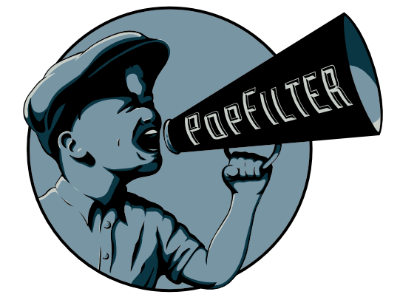Popfilter’s Foriegn Flick of the Week
In which Stephanie Reviews a Film from Notmerica
Denmark’s
The Celebration
or
“How to Clean Skeletons out of the Family Closet”
A few years ago, there emerged a movement in Denmark, called dogme 95, that tried to deconstruct films in order to tell stories that were raw and free from all the expensive bells and whistles that has encumbered modern film making. They wanted to make movies that were pure by using natural lighting, no special effects, no tripods or cameras on tracks to capture moving shots (as the camera has to be hand held,) no filters, and no artificial sounds added in editing. Predictably, the vast majority of these films were terrible. It turns out you really need those things. The problem is that no camera ever invented can even come close to what the human eye can do. Your eyes and optic nerves have evolved over millions of years to allow enough light to enter, to stabilize an image while moving and to make critical decisions about what should be in the foreground and what should be in the background.
Similarly, film has evolved over the last 100 years to compensate for the discrepancy with lighting, sound and editing techniques that enhance the experience of a film. Many directors who tried their hand at dogme 95 had a very tough time telling a story using only a camera and could have really used all the resources available to filmmakers. Their films were stagnant, had a rocky flow or, at worst, were unwatchable. However one film does stand tall from this dreadful genre, a movie called The Celebration (originally called Festen) directed by one of the founders of the dogme 95 movement, Thomas Vinterberg. Vinterberg is able to use natural lighting and sound (and even does some very impressive tracking shots by cameramen who must have a surgeon’s level of precision) in a way that is natural to the story telling.
Now, there won’t be any spoilers here, and just a bare minimum of the plot mentioned because this film presents itself much like a Russian doll; each part comes progressively from the last and it would be impossible to deconstruct out of order.
This film stands apart from the rest of the genre because of how effectively it uses the dogme 95 methodology to tell its story. It’s about a family that is gathering for their father Helge’s 60th birthday. There are other guests, but they are largely relegated to the background. They do very little, in fact they barely react to the most profoundly shocking events of the film. They are mostly just there to witnesses the action, making it real for the characters the audience is suppose to care about. The scene in which Christian, the eldest son, sees his father for the first time is an example of how this director is able to use the natural lighting to his advantage: the scene starts with the guests arriving in front of the hotel that Helge owns and is shot with the brilliant light of the noon sun. Christian is then called in to an interior room of the hotel to speak with his father alone, and the film naturally shifts to the more dark and gritty lighting of the inside of a room. This gives the scene a foreboding ominous feel that is subtle, yet unmistakable. This shift from exterior to interior lighting is a clever way to incorporate natural lighting into the story, and not become tripped up by it.
One of the things that becomes obvious when watching a bad dogme 95 film is how much directors are over reliant on a musical score, whether it is to build tension, convey the way the actors are feeling, or to make a scene impactful. This film has one scene in particular that makes a big splash, and acts as the gunshot that lets the phonies at the races know to start running. It is the sequence where Helene finds the suicide letter of the late sister; the youngest brother, Michael, slips and falls in the shower after a violent episode of screaming and sex with his wife; Christian drops a glass of water he has been playing with and Pia goes from being submerged in the tub of Christian’s room to breaking through the surface tension of the bathwater. This scene builds tension without the use of cinematographic or musical manipulation. It has a chemistry, a flow that moves with a steady verve throughout the remainder of the film. This is yet another example of the way Vinterberg uses the rules set up in dogme 95 to enhance and not detract from what is happening on the screen.
If you were so inclined to watch a movie of this movement, this is definitely the best one. Vinterberg proves himself a remarkably creative storyteller as he navigates this very strict set of rules. Rules that were meant to do for film want James Joyce and Virginia Woolf did for literature, but in the end just reminded the world that extraordinary films are not made by techniques, but by people who can use the resources available to tell their stories in extraordinary ways.
-Stephanie Rose




